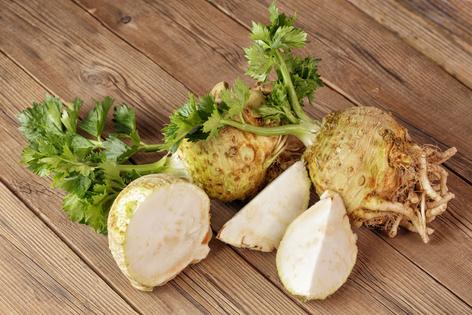Environmental Nutrition: Celebrate celery root
Celery root is gaining culinary popularity in this country, as well as appreciation for its excellent nutrient content.
The folklore
Celery root is widely known as celeriac, but is also called knob celery and turnip-rooted celery. Despite this bulbous and hairy root vegetable's reputation as the "ugly duckling" among vegetables, it has enjoyed historic popularity throughout Europe, and is mentioned in Homer's epic poem, "Odyssey," in 800 B.C. Early Greeks and Romans used celery root for medicinal and religious purposes, even as an aphrodisiac.
The facts
A member of the parsley family, along with celery, carrots, and parsnips, celery root (Apium graveolens var. Rapaceum) is a celery variety grown for its underground tuber, rather than its green, celery-like stalks. The root is usually harvested when it's three to five inches across. Beneath the rough, gnarled skin is white, crisp flesh with a celery-parsley-like flavor. A one-cup serving of celery root provides 80 percent DV (Daily Value, based on 2,000 calories/day) of vitamin K and 18 percent DV of phosphorus, for healthy bones, and 13 percent DV of heart-protecting potassium.
The findings
Research shows that dietary intake of vitamin K, from foods like celery root, may decrease risk of bone fractures (Medicine, 2017). Also rich in vitamin C, celery root provides a dietary dose of this heart-healthy vitamin. Research suggests dietary intake of vitamin C is more effective in reducing risk of high blood pressure than supplements (PLoS One, 2015). A large study on the role of fruits and vegetables on reducing risk of type 2 diabetes found that root vegetables, like celery root, were particularly effective (European Journal of Clinical Nutrition, 2012).
The finer points
Best from fall through early spring, celery root is available all year. Select roots that feel firm and heavy for their size. If stalks are attached, they should look fresh. Stored in cool, dark "root cellar" (or refrigerated) conditions, they will last months. Use a knife to remove all the skin and enjoy raw -- grated into salads or as crudites with hummus dip or cooked -- pureed into soups, cubed and roasted, sliced in gratins, or into chips baked with olive oil and sea salt.
Notable Nutrients: Celery Root
1 c (156 g), raw
Calories: 66
Dietary Fiber: 3 g (11 percent DV)
Vitamin C: 13 mg (21 percent DV)
Vitamin K: 64 mcg (80 percent DV)
Vitamin B6: 0.3 mg (13 percent DV)
Phosphorus: 179 mg (18 percent DV)
Potassium: 468 mg (13 percent DV)
Manganese: 0.2 mg (12 percent DV)
Celery Root and Cauliflower Puree
Serves 6
Recipe adapted courtesy Frieda's Specialty Produce
1 medium celery root (about 1 pound)
1 small head cauliflower (about 1 pound), cut into small florets
3 tablespoons extra-virgin olive oil
Salt and pepper, to taste
1. Peel and cut celery root into 1/2-inch cubes.
2. In large saucepan with steamer basket, add cauliflower, celery root and 3 inches of water; steam until tender, about 15 minutes. Reserve about 1/2 cup steaming liquid.
3. Add steamed vegetables to food processor container with oil, and process until smooth. (Add more steaming liquid if puree is too thick.) Season to taste. Serve hot.
Nutrition information per serving: 88 calories, 7 grams (g) fat, 1 g saturated fat, 6 g carbohydrate, 1 g protein, 2 g dietary fiber, 2 g sugar, 253 milligrams sodium.
(Environmental Nutrition is the award-winning independent newsletter written by nutrition experts dedicated to providing readers up-to-date, accurate information about health and nutrition in clear, concise English. For more information, visit www.environmentalnutrition.com.)







